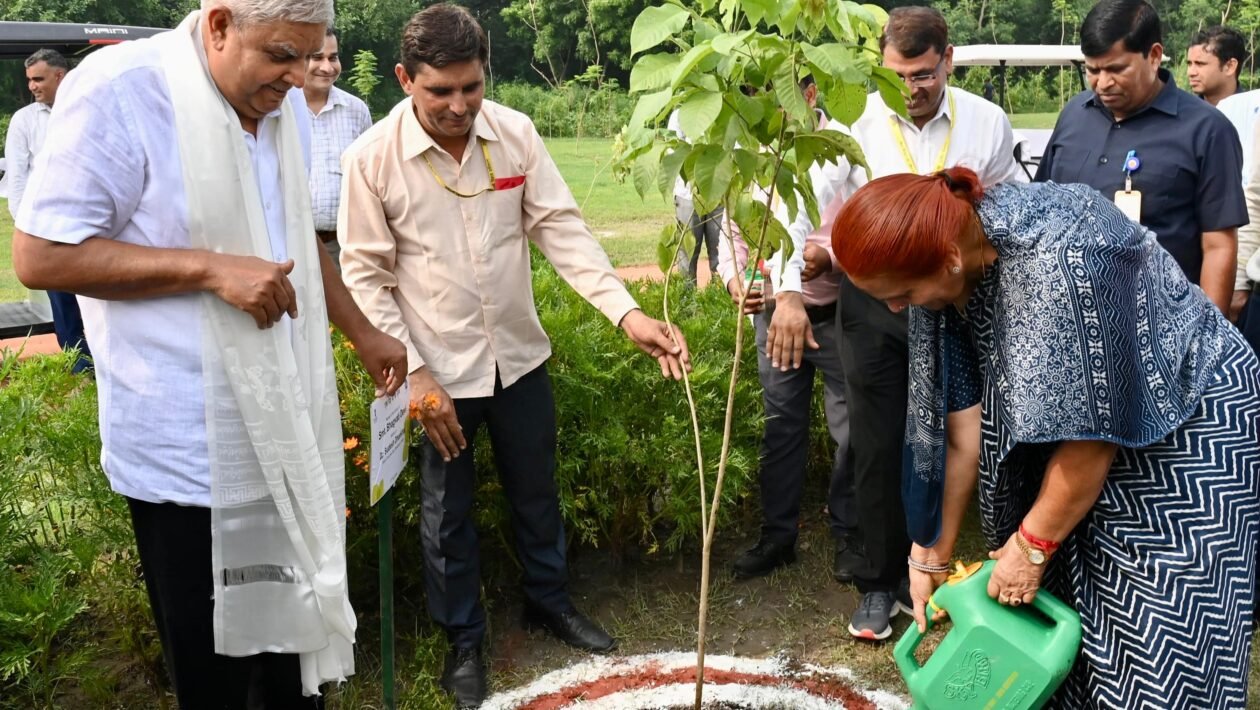- 11,000 trees planted across the Capital at different locations / DDA Parks on a single day.
- Delhi LG and NGT Chairperson also planted saplings in their mothers’ name on the occasion.
Hon’ble Vice President of India, Shri Jagdeep Dhankhar today led a massive plantation drive in the National Capital as part of the ambitious “Ek Ped Maa ke Naam” campaign that aims at increasing the green cover and enriching the ecology. Shri Dhankhar planted a sapling in the honour of his mother Smt. Kesari Devi at the Asita, an ecological park developed by Delhi Development Authority (DDA) on the eastern floodplains of Yamuna opposite ITO in New Delhi. He planted a sapling of Tabebuia Rosea (commonly known as rosy trumpet tree), a flowering tree species, along the greenway of Asita. Dr. Sudesh Dhankhar, wife of the Vice President, also planted a sapling in the honour of her mother, Smt. Bhagvati Devi at Asita.
Delhi’s Lieutenant Governor, Shri Vinai Kumar Saxena and Chairperson of the National Green Tribunal (NGT), Justice Shri Prakash Shrivastava also planted saplings in the honour of their mothers Smt. Vedwati Saxena and Smt. Kamla Srivastava, respectively, at the venue. The saplings planted today at Asita included Jamun, Gular, Tabebuia, Arjun, Shisham, Guava, Largestroemia and Jacaranda.
Simultaneously, a total of 11,000 trees were planted today in various parks and green belts of Delhi by the DDA by students, RWAs, common Delhi residents and officials.
Shri Dhankhar interacted with over 250 school children, who had assembled at Asita for the plantation drive, and administered them a pledge that they would also urge their family members to plant trees for a greener and sustainable Delhi. The school children too planted saplings at Asita Park with great enthusiasm.
Speaking on the occasion, Shri Dhankhar appealed for making the “Ek Ped Maa ke Naam” campaign a huge success and said tree plantation was the easiest, yet the most effective way of protecting our environment. The Vice-President said that he as Chairman of the Rajya Sabha, has also urged every Member of Parliament to plant at least 200 trees, as their contribution to protect the nature.
Notably, on the World Environment Day this year, Hon’ble Prime Minister Shri Narendra Modi had launched the ‘Ek Ped Maa Ke Naam’ Campaign, with an aim to increase the green cover and protect the environment.
The Vice-President, who also went for bird-watching and took a ride of the Asita Park along its wetlands and the grasslands, appreciated the DDA for painstakingly and scientifically restoring this stretch of the Yamuna floodplain into a bio-diversity park, which was just two years ago, lying as a polluted and degraded land under heavy encroachment. During the nature walk, Shri Dhankhar was explained at length the scientific process of ecological succession used by DDA for restoration of Yamuna Flood Plains at Asita and several other locations in Delhi.
Senior officers of Delhi Government and DDA, including Chief Secretary Naresh Kumar and DDA Vice Chairman Subhasish Panda also participated in the plantation drive at Asita, planting trees in their mothers’ name.
It may be noted that Asita has been developed as a bio-diversity park over 225 acres of land on the Yamuna Floodplains, which was, till May 2022, under massive encroachment by squatters and stray cattle that were polluting Yamuna severely. Following the Delhi High Court’s order to remove encroachment from the Yamuna flood plains, DDA, under the guidance of LG, VK Saxena, initiated a massive drive to clean this degraded land while restoring and rejuvenating River Yamuna and its flood plains. By November 2022, this area was transformed into one of the biggest breathable, public green spaces in entire East Delhi.
The area along the edge of the river has been developed as an ‘Ecological Zone. The restored floodplains have kachha trails for people to walk through the floodplain forest and grasslands. The floodplain forest & grassland have been created with plantation of nearly 34 lakh riverine grasses of about 12-15 species and another 6000 native trees. A water body measuring 6 acres has been created, which augments around 60 million litres of water and along with the surrounding marshy area, has led to the revival of the riverine ecosystem’s integrity and biodiversity of the flood plains. These interventions helped the area attract a large variety of birds. Till now, nearly 180 species of resident and migratory birds have been spotted in different habitats created in the form of wetlands, grasslands and floodplain forests.


